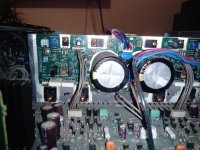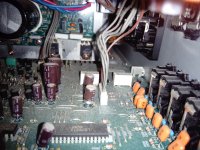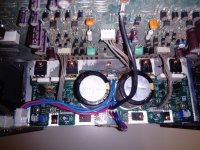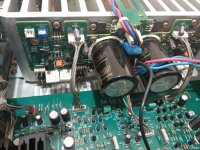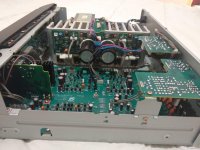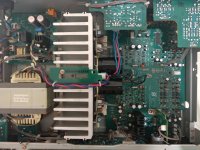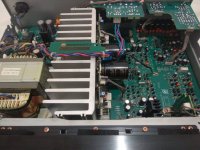Hello guys,
My integrated amp is old around 6-7 years. If you take a look at the pictures (attachment ) you ll see tones on sticky dust from which i cannot get rid off. I tried with compressed air but no luck. It looks like the dust is glued on the board 🙂 . Does anyone have any idea how to clean the amp?
My integrated amp is old around 6-7 years. If you take a look at the pictures (attachment ) you ll see tones on sticky dust from which i cannot get rid off. I tried with compressed air but no luck. It looks like the dust is glued on the board 🙂 . Does anyone have any idea how to clean the amp?
Attachments
Isoprophyl alcohol is cheaper. I use cotton balls on the end of a screwdriver. Unplug before cleaning.
I tie a sticky fiber filter over the fan in my PA equipment. No telling how many changes of output transistors that might have saved. The PV-4c had 4 sets of initials by them. I added some fins to that heatsink, too.
I tie a sticky fiber filter over the fan in my PA equipment. No telling how many changes of output transistors that might have saved. The PV-4c had 4 sets of initials by them. I added some fins to that heatsink, too.
At your own risk... but I've washed countless circuit boards over the years. Hot water, soft brush and a little detergent and it would come up like new. You need care in drying it out afterwards. Use paper towel to wick up as much moisture as possible from around and under components such as the IC's. Use a hair dryer to give it an initial drying and then place somewhere really warm bordering on hot to dry it thoroughly.
Post #10:
Washing an amplifier board
Post #10:
Washing an amplifier board
Cotton swab/bud with isopropyl alcohol. Mind you, isopropyl alcohol also dissolves some adhesives (it is often used as a sticker remover) and in some rare cases it dissolves texts printed on components. In most cases it works just fine, though; in fact it is often used to remove flux residues from printed circuit boards during manufacturing.
First I use compressed air.
Then Isopropyl alcohol and sometimes flux remover like Contact Chemie PCC.
I then apply Plastic 70 coat to the solder side.
The problem is to be careful not to wipe of the heatsink grease.
Then Isopropyl alcohol and sometimes flux remover like Contact Chemie PCC.
I then apply Plastic 70 coat to the solder side.
The problem is to be careful not to wipe of the heatsink grease.
tones on sticky dust from which i cannot get rid off.
I would leave it alone, if it's working ok. Maybe gently wipe the heat sink fins with a microfiber cloth.
Check out the liquid audio website in Perth western Australia. He uses Ambersil foaming cleanser. last I checked it had to be shipped in from Europe. There are other foam board cleaners.
Regards,
Kffern
Regards,
Kffern
At your own risk... but I've washed countless circuit boards over the years. Hot water, soft brush and a little detergent and it would come up like new. You need care in drying it out afterwards. Use paper towel to wick up as much moisture as possible from around and under components such as the IC's. Use a hair dryer to give it an initial drying and then place somewhere really warm bordering on hot to dry it thoroughly.
Post #10:
Washing an amplifier board
I'll second that. The key is drying time. Most boards are washed after assembly when new, so it's nothing unusual.
Quit smoking.Hello guys,
My integrated amp is old around 6-7 years. If you take a look at the pictures (attachment ) you ll see tones on sticky dust from which i cannot get rid off. I tried with compressed air but no luck. It looks like the dust is glued on the board 🙂 . Does anyone have any idea how to clean the amp?
+1, isopropanol + compressor ,if the amp is too annoying to dismount.
otherwise, also hot water with washing up liquid
or oven cleaner without soda if really it's too dirty
otherwise, also hot water with washing up liquid
or oven cleaner without soda if really it's too dirty
Thank you everyone. I've managed to fully clean using only 96% Alcohol and tooth brash 🙂. Pictures below
Attachments
I often wash boards after assembly, water, toothbrush and compressor to blow any remaining liquid out from under parts before leaving overnight.
I would leave it alone, if it's working ok. Maybe gently wipe the heat sink fins with a microfiber cloth.
Sticky dust may harbour moisture and lead to corrosion, electrical leakage, I'd be less forgiving of the stuff. Since I regularly populate PCBs I'd be tempted to use
PCB flux cleaning solvent and old brush (but gently with delicate components), but IPA is fine. Cleaning a board is a good opportunity to inspect it closely too.
I'd not use water, some components may be sensitive to it.
When using solvents always ensure adequate ventilation etc etc....
- Status
- Not open for further replies.
- Home
- Amplifiers
- Solid State
- Help me rid of sticky dust
